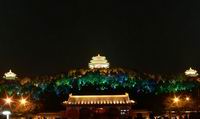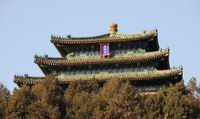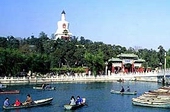
Jingshan Park
Category: Cultural Relics Sites
Address : North of Forbidden City, Beijing
Open Time : Daily 6:30am - 6:00pm
Reviews: ![]()
Phone : 86-10-64044071
Entrance fee: RMB 5/p.p

Introduction of Jingshan Park Beijing
The Jingshan Park, as a beautiful royal landscape garden, is situated in the center of Beijing City. Covering an area of 230,000 square meters (about 57 acres), the park stands on the central point of the south-north axis of Beijing City and faces the north gate of the Forbidden City. Jingshan Park is found on Jingshan Hill, which was originally named Wansui Hill (Long Live Hill), Zhen Hill or Meishan Hill (Coal Hill). The mid summit of Jingshan is the highest point in Beijing. Looking from the peak, the visitor is able to get a full and clear view of the Forbidden City.
During the Yuan (1271-1368), Ming (1368-1644) and Qing (1644-1911) dynasties, Jingshan Hill served as an imperial garden and was properly laid out under the Ming Dynasty when numerous fruit trees were planted as well as many palaces and pavilions built for the emperor to make sacrifices to his ancestors. As a result, the royal families always enjoyed amusements here, like hunting in the hills. Then, in 1928, it was opened to the public. Later, after 1949, the park was fully rebuilt, with the paths in it paved and most of the buildings renovated. Now, the present Jingshan Park is one of the 'AAAA' Scenery Spots in China and a 'must' for visitors to Beijing.
Upon entering the front gate of the park, visitors can see the Qiwang Pavilion, embraced by the vigorous green cypresses. This was originally the place for emperors to worship the memorial tablet of Confucius. Surrounded by white marble balustrades, the two-storied pavilion with its golden-glazed roof appears quite dignified.

The Jingshan Hill has five summits, and on each summit there is a pavilion, built in 1751. In every pavilion, there was originally placed a copper Buddha statue which represented one of the five tastes-sour, bitter, sweet, acrid and salt. It is a pity that they were all lost during the warfare of 1900. Among the five pavilions, the Wanchun Pavilion (Ten Thousand Spring Pavilion), on the middle of the five summits, sits at the hill's central point as well as being at the highest point in Beijing. It is a perfect place to appreciate the full view of Beijing City. From this pavilion, visitors are able to see the resplendent and magnificent Forbidden City in the south, the dignified Bell and Drum Towers in the north, as well as the White Dagoba in the west.
In the north side of the Jingshan Hill is found the Shouhuang Hall, originally the place for the emperors in the Qing dynasty to pay their respects to their ancestors. Some of the emperors' portraits were worshiped in it. To the east of the Shouhuang Hall, stands the Yongsi Hall, the place for resting the dead bodies of the past emperors and queens.
Jingshan Park also boasts some charming natural scenery with a planted area in the park of about 1100 square meters (about 1316 square yards). This park is the biggest peony rose garden in Beijing and during May each year, with the 20,000 peony roses of some 200 varieties in full bloom the park displays a wonderful and colorful scene. Visitors who are interested in flowers will find some rare and famous varieties to please them. We hope you enjoy your visit to Jingshan Park when you are in Beijing.
Beijing-Travels.com offers online information on Beijing Jingshan Park and private tours as follows, Keep browsing our site for More Attractions information in Beijing China.
Private Tours of Jingshan Park

If you could not meet a interesting tours which our predesigned with Jingshan Park, we will customize a tour to fit your exact needs.
Special Offer Travels
Beijing-Travels.com is a full service local travel agency offers popular travel packages to Beijing, Great Wall and all over of China. We specialize in "PRIVATE" & "NO-SHOPPING" tours and try to be original, unique and best to satisfy our clients, Let us assist you to experience your own vacations!

